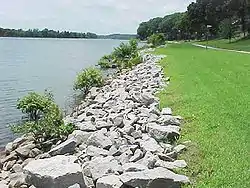Riprap
Riprap (in North American English), also known as rip rap, rip-rap, shot rock, rock armour (in British English) or rubble, is human-placed rock or other material used to protect shoreline structures against scour and water, wave, or ice erosion.[1][2][3] Riprap is used to armor shorelines, streambeds, bridge abutments, foundational infrastructure supports and other shoreline structures against erosion.[1][2][3] Common rock types used include granite and modular concrete blocks.[4][5] Rubble from building and paving demolition is sometimes used,[3][6] as well as specifically designed structures called tetrapods.

Riprap is also used underwater to cap immersed tubes sunken on the seabed to be joined into an undersea tunnel.
Environmental effects
Sediment effects
Riprap causes morphological changes in the riverbeds they surround. One such change is the reduction of sediment settlement in the river channel, which can lead to scouring of the river bed as well as coarser sediment particles. This can be combatted by increasing the distance between the pieces of riprap and using a variety of sizes.[7]
The usage of riprap may not even stop erosion, but simply move it downstream.[8] Additionally, the soil beneath the riprap can be eroded if the rock was just placed on top without any buffer between the layers such as a geotextile fabric or smaller riprap (crushed stone).[9]
Changes in organic material and the ecosystem
Riprap affects the amount of organic material in a waterbody by acting as a filter, catching wood and leaves before they can enter the water.[8] Riprap also covers and prevents plants from growing through, which can reduce shade over the water.
Introducing ripraps creates a rocky environment which can affect the ecology of a waterbody by making the ecosystem more heterogeneous.[10] While it can negatively affect some organisms by removing shoreline vegetation, the rock can provide important refuge for invertebrates and small fish.[8][11] By preventing woody plants from growing and shading the water, riprap can also increase the amount of algae and hydrophytes.[12]
Gallery
 Concrete rubble used as riprap along the San Francisco Bay shoreline
Concrete rubble used as riprap along the San Francisco Bay shoreline Modular concrete block riprap
Modular concrete block riprap Modular concrete block riprap
Modular concrete block riprap Modular concrete block riprap
Modular concrete block riprap Riprap lining a lake shore
Riprap lining a lake shore.jpg.webp) Riprap closing off a channel on the Mississippi River
Riprap closing off a channel on the Mississippi River.jpg.webp) Riprap protecting a levee
Riprap protecting a levee Crews replacing riprap at Galveston Seawall after a 1915 hurricane
Crews replacing riprap at Galveston Seawall after a 1915 hurricane Riprap protecting a concrete retaining wall
Riprap protecting a concrete retaining wall
References
- Trmal, Céline; Dupray, Sébastien; Heineke, Daan; McConnell, Kirsty (2009). "USING ROCK IN HYDRAULIC ENGINEERING – NEW GUIDANCE AN UPDATED VERSION OF THE MANUAL ON THE USE OF ROCK IN HYDRAULIC ENGINEERING". Coastal Structures 2007. Venice, Italy: World Scientific Publishing Company: 220–224. doi:10.1142/9789814282024_0020. ISBN 978-981-4280-99-0.
- Breakwaters, coastal structures and coastlines : proceedings of the international conference organized by the Institution of Civil Engineers and held in London, UK on 26-28 September 2001. Allsop, N. W. H., Institution of Civil Engineers (Great Britain). London: T. Telford. 2002. ISBN 0-7277-3042-8. OCLC 51483089.
{{cite book}}: CS1 maint: others (link) - "What is Riprap | Muse Hauling & Grading". www.musehg.com. Retrieved 2020-12-07.
- Aguilera, Moisés A.; Arias, René M.; Manzur, Tatiana (2019). "Mapping microhabitat thermal patterns in artificial breakwaters: Alteration of intertidal biodiversity by higher rock temperature". Ecology and Evolution. 9 (22): 12915–12927. doi:10.1002/ece3.5776. ISSN 2045-7758. PMC 6875675. PMID 31788225.
- "Erosion Control Blankets vs. Rip Rap | East Coast Erosion". East Coast Erosion Control. 2020-05-22. Retrieved 2020-12-06.
- Brown, Scott A. (January 1989). "Welcome to ROSA P |". rosap.ntl.bts.gov. Retrieved 2020-12-06.
- Qi; et al. (June 2021). "Scour at pile groups and effects of riprap gradation and thickness on the scour reduction". Journal of Hydraulic Engineering. 52 (6) – via ResearchGate.
- Reid, David; Church, Michael (2015). "Geomorphic and Ecological Consequences of Riprap Placement in River Systems". JAWRA Journal of the American Water Resources Association. 51 (4): 1043–1059. Bibcode:2015JAWRA..51.1043R. doi:10.1111/jawr.12279. S2CID 129730847.
- Sfeir; et al. (August 2021). "RIPRAP FILTERS AND STABILITY OF RIPRAP COVERED SLOPES". Riprap for Scour Countermeasures – via ResearchGate.
- Shields; et al. (June 1995). "Experiment in Stream Restoration". Journal of Hydraulic Engineering. 121 (6): 494–502. doi:10.1061/(ASCE)0733-9429(1995)121:6(494) – via ASCE Library.
- Chhor, Auston D.; Glassman, Daniel M.; Smol, John P.; Vermaire, Jesse C.; Cooke, Steven J. (2020). "Ecological consequences of shoreline armoring on littoral fish and benthic macroinvertebrate communities in an Eastern Ontario lake". Aquatic Sciences. 82 (4): 73. doi:10.1007/s00027-020-00740-0. ISSN 1015-1621. S2CID 220857360.
- Fischenich, J. Craig (April 2003). "Effects of Riprap on Riverine and Riparian Ecosystems" (PDF). Wetlands Regulatory Assistance Program. Archived (PDF) from the original on June 1, 2022 – via US Army Corps of Engineers.
- Ciria-CUR (2007) - Rock Manual - The use of rock in hydraulic engineering.
- N.W.H. Allsop (2002) - Breakwaters, coastal structures and coastlines.
- US Dept. of Transportation (2004) - Trail Construction and Maintenance Notebook
